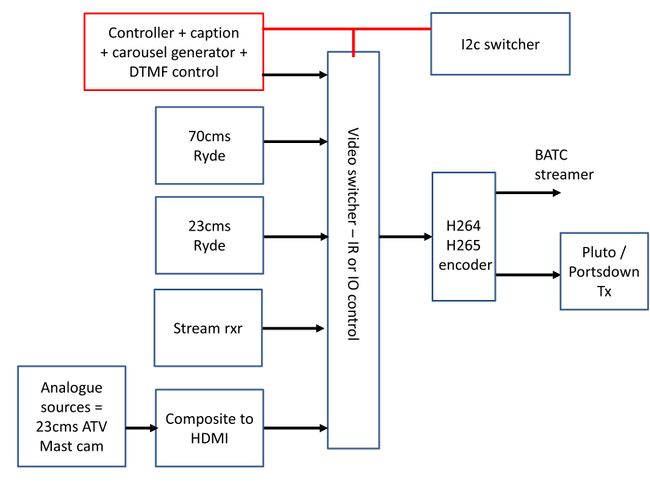Repeater Controller
The BATC ATV Repeater Controller uses a Raspberry Pi 4 as a fully-featured, but simple-to-implement, ATV repeater controller. Every repeater is different and the controller is designed as a core logic that can be used as the basis for an ATV repeater. The design is flexible with a large number of parameters in a text editable config file so that users can configure it to meet their own needs.
The controller is intended to be used with an HDMI Video switch, but can also be used with other switchers including older composite video designs.
The outline requirement specification is here media:BATC ATV repeater controller.pdf
Typical operation
The BATC repeater controller controls single or multiple video switchers either by InfraRed, I2C or GPIO pins. It also generates a carousel of scenes and has an on-board DTMF decoder.
Carousel
The carousel can be configured to show up to 99 scenes. The content and duration displayed of each scene is set in the configuration file and the scene can be one of the following:
- Status screen generated by the controller
- jpg or png images played out by the controller
- Video files (in future release).
- Any input on the video switcher, so can display inputs such mast cams, weather stations or Quad video displays.
The still images are read each time before display so can be regularly updated by an external source.
Valid signal input
On receipt of a valid signal from, for example, a Ryde receiver, the controller will, key the transmitter, play an image for .5 seconds indicating which input has been activated and then switch to that input. When the receiver closes, the logic will play a "K" image and optional "K" in Morse and go back to the carousel.
The receiver input switching line can be directly from a Ryde receiver or an external source such as a sync detector on an analogue source. Note do NOT exceed 3.3 volts on the GPIO input.
Ident signal
In order to comply with licensing regulations, a video and/or audio ident can be generated at an interval set in the config file.
DTMF control
An on-board DTMF decoder will allow input selection by remote control and also enable GPIO pins to be toggled to enable the control of external equipment.
Power saving
To enable power saving by turning the repeater transmitter off during quiet periods, a number of options are available such as only key the transmitter when in repeat mode, do not key the transmit during the night time and only key the transmitter to display the carousel for the first 30 minutes of every hour.
Hardware control
The controller will interface to the following:
- Video switches via IR transmitters - up to 2 IR transmitters can be configured separately allowing multiple video switches to be cascaded.
- Video switchers via hardware lines driven from the RPi GPIO lines (note 3.3v logic output)
- I2C support for the Audio switch designed for GB3SQ. Details of the 8 channel input audio switch PCB can be found here: DATV repeater audio switch
Future releases may support I2C video switches and relay boards.
The IR and i2c commands for each input are set in the config file.
Configuring IR Switching
The IR codes for the video switches used on a repeater will need to be entered in the configuration file.
Full details on how to read your IR commands and then configure the system are here: Configuring IR for HDMI Switching
Customisation
While this software is designed to work "out of the box" it will need to be configured for each individual repeater.
For a detailed description of the configuration details see the Repeater Controller configuration page.
Some configurations can be done using the SSH menu and some real-time control is possible using the ssh Console Menu.
DTMF control
The BATC repeater controller uses an onboard DTMF detector which detects DTMF from the mic input on a USB audio dongle (using a standard Portsdown white USB dongle).
Full details of the functions that can be set by DTMF and their configuration are on this page DATV repeater DTMF commands
GPIO Connections
The repeater controller accepts up to 8 signal detect inputs on the GPIO input pins and uses IR / I2C or GPIO outputs to control video switchers.
Care MUST be taken to buffer the 3.3 volt logic levels used on the Raspberry Pi GPIO pins.
An initial list of GPIO connections is here: Repeater GPIO Connections.
Switching Logic
A detailed description of the operation of the switching logic can be found here: Repeater Switching Logic.
Project status
The target release date is the end of March 2022.
Jan 22 - Alpha release for testing
Feb 10th 2022 - A Beta release version of the software is available for download: https://github.com/BritishAmateurTelevisionClub/atv-rptr
Note this is NOT the final release and there will be bugs! Please provide feedback on the forum.
Feb 15th - Feature freeze until first release in March
Future requirements
Currently, we are not adding additional features until the design is proven to be stable.
The following features have been identified for inclusion in future releases:
- Implement battery-backed clock (for no internet/power cuts). Will serve NTP to Rydes on same network
- VLC Carousel Play of videos
- i2c accessory switch operation (Entries exist in config file, but not yet coded)
